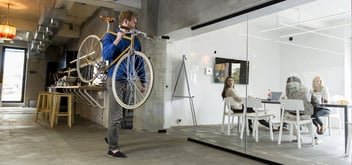“We shape our buildings; thereafter they shape us.”
– Winston Churchill
There are many things we may assume when it comes to workplace or office design. For instance, we might believe an open plan layout suggests a modern mindset, or incorporating a ping-pong table into the office demonstrates we are edgy and dynamic to young people, or that piping chill-out music through the workplace will help your team relax.
But what if the nature of your business requires heavy concentration with minimal distraction? And what if nobody is going to use the ping-pong table, whether they are young or not? And what if some of your people find chill-out music incredibly irritating? This is where your workplace design and company culture are more important than you think.
Instead of assuming what is best for your workplace and following a template of ‘cool things’ as dictated by other businesses around the world, your office or workplace design should be grounded in evidence that is specific to you and – even more specifically – specific to the nature of your particular site, if your organisation is spread across multiple locations.
This is the difference between evidence-based design and assumption-based design and it can be the difference between having a new design that works for you or is merely a waste of time and dollars.
What is evidence-based design?
Evidence-based design is the process of configuring your office around the culture of your organisation and the way you work, rather than forcing your team to work around an imposed design scheme.
When evidence-based workplace design is correctly actioned, your office redesign or relocation project has the ability to enhance productivity and help your people achieve more. According to Envoplan in the UK, implementing evidence-based office design can even result in real-estate savings, often saving space by up to 30 percent.
The process of collecting then evaluating the evidence to inform your design is a process that needs to be enacted by professionals. By choosing a professional workplace partner, you ensure the appropriate evidence is collected and then applied in the best manner. However, you can start by asking yourself some of the questions a workplace design partner will be asking to move you into the next phase in your company’s evolution.
What is your workplace culture?
Now really think about this question. In fact, you might need to ask yourself a series of mini-questions in order to paint a proper portrait of your company’s culture. For example:
What does your brand represent and how are these qualities reflected in your workplace culture? Show practical examples of how these qualities are reflected in your business, rather vague platitudes; such as how you’re an eco-friendly business and, therefore, you only use sustainable materials in the office, etc.
Is there an overall personality to your workforce? Do you employ a certain type of person – introverts or extroverts or a mix of both? Is your office a multi-generational one? All of these questions help build a profile of your people and how their different personalities can be incorporated into the design.
What are the habits of your workforce?
In this new technological climate of flexible workspaces, the office is no longer the place where everyone works. In fact, it’s highly likely your official company office is only inhabited 50 percent of the time. In this regard, the habits of your workforce will have a great impact on your workplace fitout or design.
As Annelie Xenofontos, Senior Workplace Strategist at Axiom, states, “There’s no use putting Google-style beanbags in the office if your team wear pencil skirts.”
So, once again, ask yourself some further questions:
Do you have a workforce that is united in the way it works and the tasks that need to be fulfilled, or is everyone functioning in a unique fashion? You might have salespeople on phone calls and conducting meetings everyday while there are other members of your team trying to write legal briefs and tenders. This is a case where an open plan office layout could be detrimental to the productivity of your workspace, especially for those who need quiet zones.
Does your workforce move around the workplace across the course of the day? If not, could they benefit from such mobility? Could they – and do they want to – work from home? Maybe you’ve had team members complain about where they are expected to work or other elements of the office?
Where do your company’s aspirations lie?
No business is a static entity, or one that should remain fossilised the same way forever. All companies are organic and can move in whatever direction they wish – with a little bit of careful planning, of course. Therefore, you need to think about your company’s aspirations before introducing a new office design:
What changes would you like to make to the way your business operates on a daily basis? What currently irks you and your team members about your workplace? And – it’s an oldie but a goodie – where would you like to see your organisation in five years’ time? What would your future and the future of your workplace culture look like?
These are just some points of view to get your head around for an evidence-based approach to office design. Once it’s put into action, rest assured, you’ll never rely on assumptions again.
Ask Axiom today about our latest advances in evidence-based workplace design.







